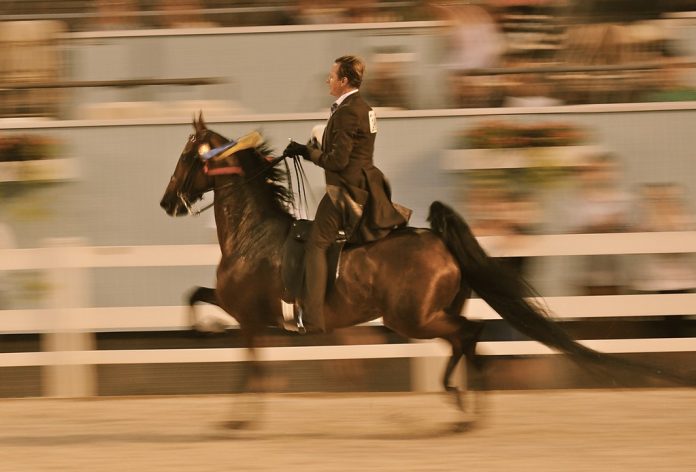Five-gaited horses! These riding horses are usually taught two extra gaits in addition to the natural gaits. Natural gaits for most horses are the walk, trot, and canter. Five-gaited horses as well use the slow gait and rack. The walk and trot gait are generally recognizable to most people. The canter is a slow, smooth, rhythmic three-beat gait as opposed to the high-action four-beat trot.
The slow gait is a high stepping four-beat gait also referred to as the promenade, stepping pace (slow pace), running walk, foxtrot, and maybe other terms, but of these only the stepping pace is traditional as a slow gait for show purposes. The rack (that is also called a single foot) is a speedy, showy, four-beat gait free of pacing action. In most cases, the slow gait and rack are learned responses while the walk, trot, and canter are natural gaits.
There are some instances, however, in which certain breeds or types of horses are naturally five-gaited and do not have to be trained to develop the slow gait and rack. A unique characteristic of any five-gaited riding horse when shown is that it is always shown with a long, flowing mane and full tail. Examples of breeds of five-gaited horses are the American saddle horse and Racking Horse.
Three-gaited horses. The walk, trot, and canter are natural gaits of horses, and many light breeds from the Arabian to the Thoroughbred fall into this category. Three-gaited riding horses are more often than not discernible from five-gaited horses because the three-gaited types are shown with mane clipped (or roached) and a clipped tail. Five-gaited horses, as previously mentioned, are shown with a full, flowing mane and tail.
Stock horses. The open range and rodeo arena are home to the stock horse. Examples of these breeds are Arabians, Grade horses, Quarter horses, Thoroughbreds, and many other light breeds that also qualify for working equines.
Polo horses. This fine athlete must have tremendous stamina, strength, and speed. The breeds that dominate the polo field are the Thoroughbred, crossbreeds involving the Thoroughbred, and many grade horses of all types. The prime prerequisite is athletic ability.
Hunters and jumpers. These horses are also great athletes, noted for their strength, stamina, and natural ability to jump. The breeds that dominate the hunter/jumper classes are the Thoroughbred, and especially important in recent years has been a cross between the Thoroughbred and Cleveland Bay. Jumpers are horses that are bred for jumping competitions and steeplechase races. Hunters are strong jumpers used to follow the hounds such as in fox hunting. Hunters and Jumpers differ little except in the purpose for which they are used.
Ponies. This is a very popular category for children and short adults. There is a tremendous variety of breeds available in the riding pony type. A few examples of breeds are the Pony of the Americas, Shetland, Connemara, and Welsh. Other pony breeds are also discussed in this chapter.
The layman normally thinks of a racehorse as a thoroughbred animal ridden by a jockey in the Kentucky Derby. Even though this is understandable, there are other types of racehorses, such as harness racehorses (trotters and pacers), and Quarter racehorses. The Thoroughbred dominates the running races to the exclusion of virtually all other breeds. The Standardbred is entirely used in harness races and the Quarter horse is the breed developed for quarter races.
